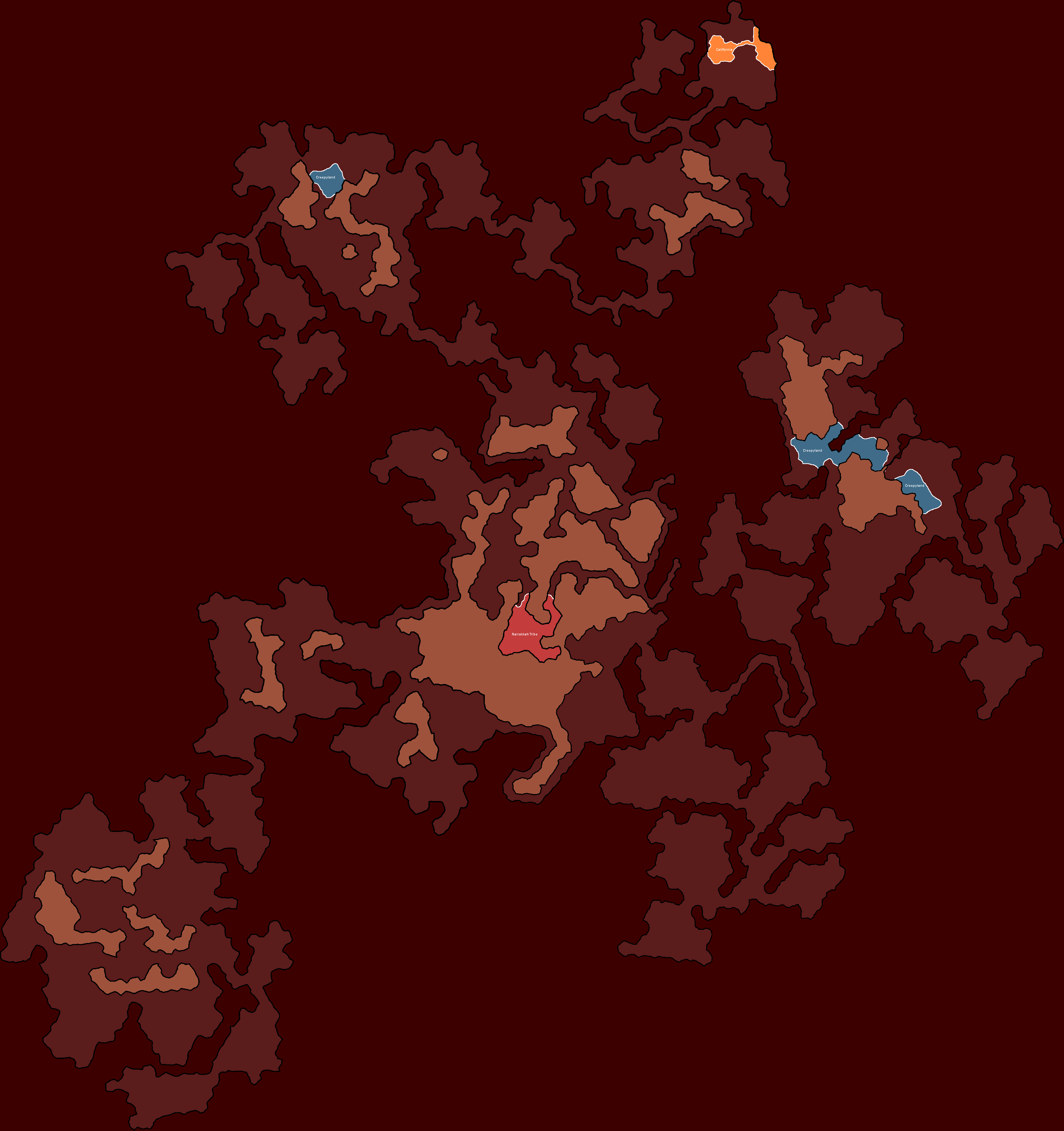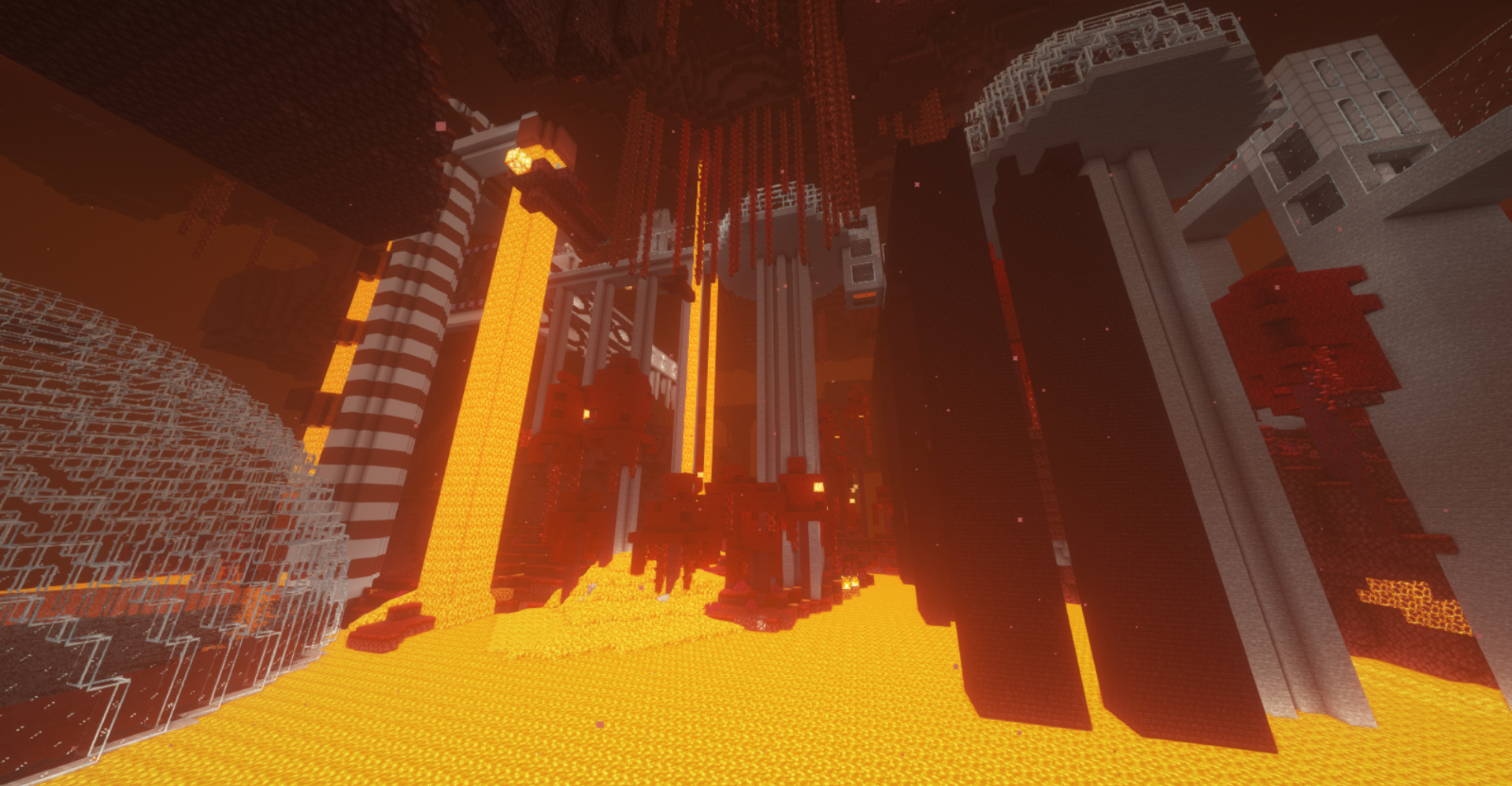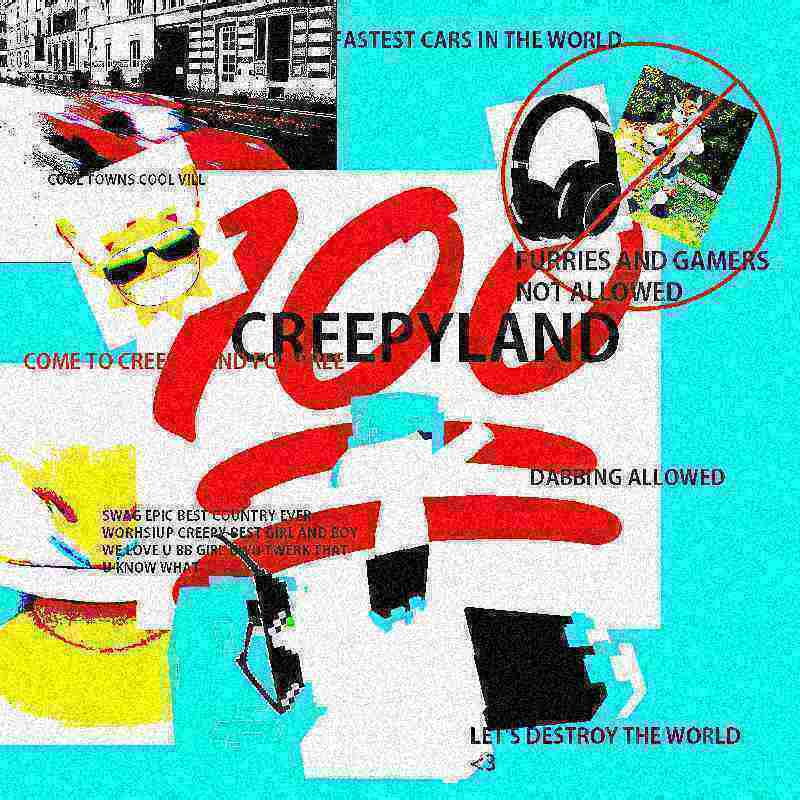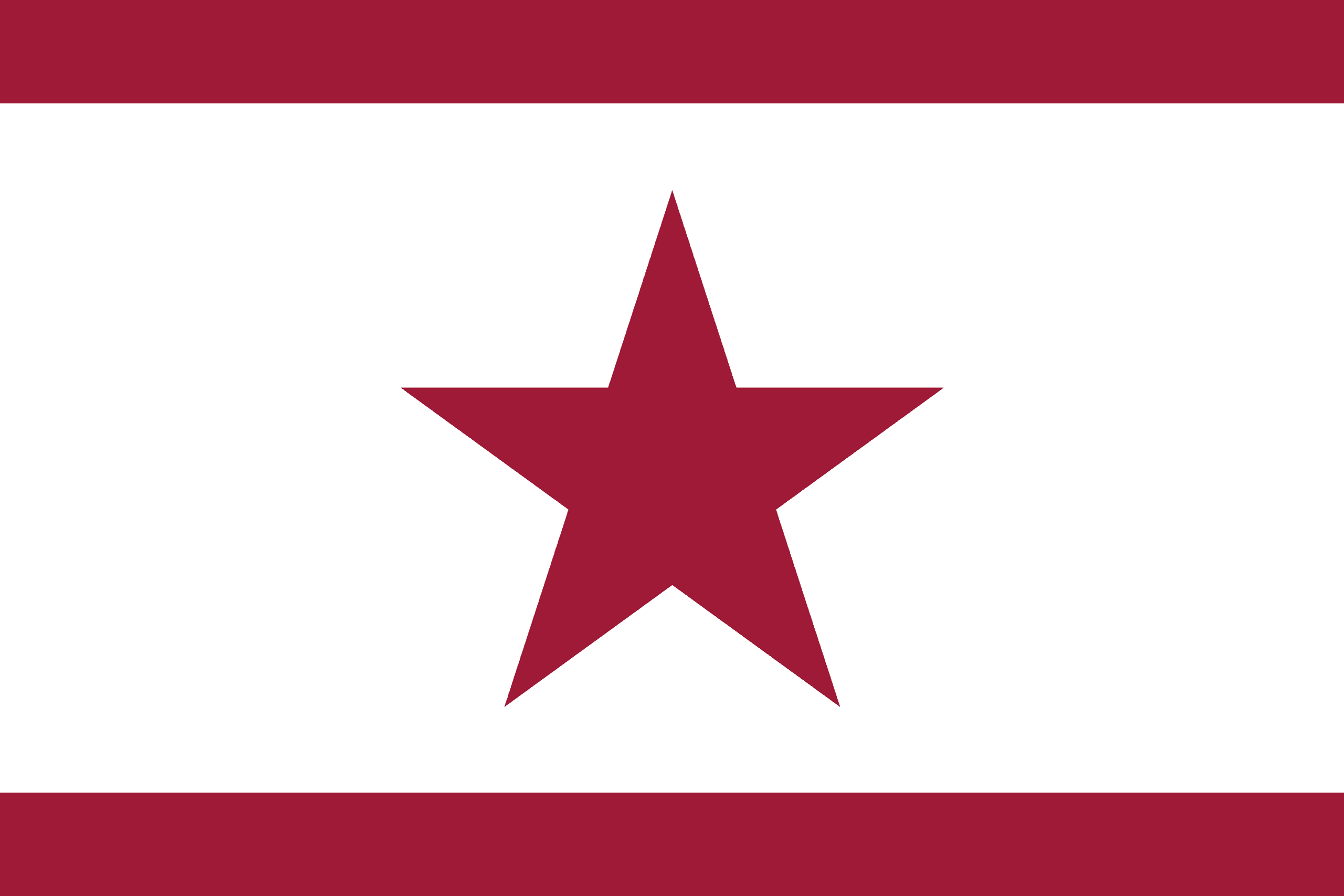Narakam
| Narakam | |
|---|---|
  | |
| Astrographical Information | |
| System | Alpha Sol System |
| Suns | The Sun |
| Moons | Narralt |
| Rings | Faint rings composed mainly of rock and dust. |
| Orbital Position | 5 |
| Rotation Period | 78 Days |
| Orbital Period | 387 Days |
| Galaxy | Milky Way |
| Rim | Center |
| Quadrant | Alpha |
| Grid Coordinate | N19 |
| Physical Information | |
| Class | Terrestrial |
| Diameter | 11567 km |
| Atmosphere |
|
| Climate | Volcanic |
| Primary Terrain |
|
| Surface Water | 0% |
| Habitability (%) |
|
| Average Surface Temperature (°C) |
|
| Flora | Various fungus-like plantlife in caverns. |
| Fauna | |
| Societal Information | |
| Official Title | Confederation of Narakamian Peoples |
| Government Type | Federal Parliamentary Republic |
| Administrator |
|
| Demonym | Narakamian |
| Native Species | Narakamians |
| Immigrated Species |
|
| World Languages | |
| Population |
|
| Major Exports |
|
| Major Industries |
|
| Notable Nations | |
| Sector | Sol Sector |
| Affiliation |
|
| Organized In | 498 CE |
Narakam is the fifth planet from the Alpha Sol, having an eccentric orbit that crosses Theia's[1]. It is one of the harshest habitable planets to be discovered by Humanity[2], being characterised by rugged, unscalable mountains and fierce rocky terrain surrounded by seas of lava; it is near impossible to sustain oneself upon the surface as, much like neighbouring Venus, the runaway greenhouse effect keeps the surface no colder than 200 degrees Celsius.
Despite its harsh surface, Narakam is better known for its milder underground, a large cavity spanning the entire circumference of the planet featuring large monoliths of rock that hold the surface above the oceans of lava below, with this lava heating up this area to a much higher temperature than should be habitable. Despite how harsh the underground should be, the native sapient extremophiles known as the 'Narakamians' managed to construct large vents to the surface, venting out the heat over time in an attempt to mould their home into something more habitable. This cooled the underground to a much milder 60 degrees, allowing Humans and most other sapients to live and work in the Narakamian underground. Although unappealing at first, Narakam is of notable interest to scientists for the study of geological activity, and miners for the extraction of its vast mineral deposits. The fauna and flora, albeit deadly, has also been proven valuable to biologists due to the study of how organisms adapt and evolve in such harsh environments, which back then had bettered their chances of discovering more extraterrestrial life.
Its hellish nature has equally made Narakam a harsh and difficult to settle land and a bastion of relative peace, stability, and innovation. Thanks to its unique climate and environment, Narakam is a perfect place to conduct research and run various industries and mining operations, as geothermal sources are able to provide a seemingly infinite source of energy to power these operations. Rather than living with a constant threat of war, many of the civilians on Narakam are descended from those that moved here searching a new life living on Narakam away from the struggles of Yata and Theia during their chaotic pasts, allowing a vibrant community of research scientists, biologists, botanists, geologists, geographers and volcanologists to advance the planet's technology while its rich and powerful resource-extraction conglomerates have enriched the planet economically..
Life in Narakam's Underground
Life on Narakam can be comfortable, but achieving the level of comfort one would expect back home on Yata or Theia is by no means an easy feat. Although Narakam is abundant with resources, most of the resources humans need have to be imported through vents to the surface. Ships that export to Narakam must be heat-resistant to make it past the surface layer and small enough to fit through the vents. As a result, cargo ships cannot arrive on Narakam itself, but usually hover above the surface or on the few shielded surface environments while deploying many smaller ships to fly down to the underground and deliver resources.

The image to the right shows Vannakaram, the main research base on Narakam. It has enough residential space to accomodate 2,530 permanent residents to conduct research in and around the base. The archetypal design of these research stations feature domed structures with their own climate system. Heat is condensed into magma and pumped out of the research station while water vapour from the surface is condensed and pumped into large containers as seen to the left. Research at Vannakaram has proven successful thus far, having proven that Yatan crops can be grown on Narakam, even with Narakamian soil provided the conditions are right.
Two experiments have been conducted to see if Narakam can be terraformed, both were successful. Narakam is in theory possible to terraform and many scientists have petitioned external governments for resources to do so, but general consensus is that Narakam should be preserved for both biological/geological reasons and the interests of the native population. Areas such as the wastes can be easily adapted for living as the rock is rigid and insulating, meaning that anything that is built in the monoliths that is properly cooled can stay cool. Living in the wastes is also beneficial due to the lack of fauna and flora, meaning that it is generally a safer place to live than other biomes, albeit this is typically not appealing for research.
Demographics
(Native) Narakamians tend to be 'Narakam-centric' and conservative, and stick to themselves rather than interacting with peoples of other worlds. Despite this, they interact mostly peacefully with the 5.6 million Humans living within the Confederation in modern times. Despite their open acceptance of modern technology, roughly 65% of Narakamians still live a tribal lifestyle, although still making use of modern technology in this lifestyle. Those who live in urban and populated areas tend to be more progressive and aligned more politically with the Human Colonists, although still often hold conservative values. This urban demographic also makes up a majority of the Narakamian diaspora and spacefaring personnel, due to the Tribal people's aversion towards off-worlders. Though the actual "ground" armed forces tend to be more equally distributed among both demographic groups.
The Human Population is generally very progressive, even more so than a majority of humans outside of Narakam. This has lead to most more recent migrants being part of various minorities, making the human population exceptionally diverse. A majority of them are also involved in various scientific fields due to Narakam being among the most notable points of interest in said circles within the Alpha Sol system, though various other industries also hold prominence.
Government and Politics

The Confederation of Narakamian Peoples is the planet-wide governing body that holds sovereignty over Narakam after being established following the Second Concordance, which replaced the Yatan-Theian Federation's "Planetary Union of Narakam" with the planet's current status as a largely self-governing 'Planetary Government' within the Yatan-Theian Accord's Federalized Territories. The Confederation asserts itself as a continuation of the 'Narakamian Confederation', a polity which governed the planet from 318 CE to 482 CE before it joined the Federation.
Institutionally, the government of the Confederation is primarily divided into 3 branches; the Executive, Legislative, and Judiciary. The Executive is a remarkably weak position headed by a figure known as the 'State Representative', a largely ceremonial position largely only responsible for diplomatic functions which is elected by the legislature for a 10 year term. The legislature is the most important branch of government, taking the form of a unicameral parliamentary body known as the 'Kharanda'[3] hosting appointed representatives of each of the various Narakamian Clans, Narakamian Tribes, Human Colonies, and Interspecies Urban Settlements to discuss their issues and manage the Confederation in a largely non-partisan manner. The most influential governing figure within the Confederation is the 'Senior Kharanda Chief' which is an unelected head of government position always held by the longest-serving member of the Kharanda, acting as the true 'leader of Narakam' in essentially all matters aside from diplomacy/foreign affairs. The final branch of government is the Judiciary which is composed of the 'Nairakkah Tribunal', a state-backed court responsible for interpreting the law and issuing punishments to the worst criminals.
Most institutions of the Narakamian Government are based in the city of Nairakkah, a large settlement found within a unusually large cavity home to one of the largest surface vents, allowing easy access from space onto the surface and vice versa. Nairakkah itself operates as a fairly standard Clan-based monarchy on the most level, although its cosmopolitan nature has allowed it to become among the more liberalized regions of the planet as some form of representative democracy is present there. Beyond Nairakkah, the quality of infrastructure tends to degrade noticeably as only a limited number of highways and railways traverse the primary cavern from end to end, though despite this there exists massive privately-run infrastructure networks dedicated to Narakam's by far most lucrative trade; resource extraction.
Accord Representation
Thanks to each clan, tribe, colony, and urban settlement typically only having a couple representatives dedicated to their own local regions' development rather than the interests of the entire planet's populace, the Kharanda is remarkably non-partisan as no formal political parties exist as a 'pan-narakamian ideological synthesis' that naturally emerged thanks to cooperation with rural communities and the advanced urban areas, combining ideals of developmentalism with entrenched traditionalism. While internally Narakam is largely apolitical, the situation is quite different when it comes to the planet's representation in the Accord's 'Interplanetary Assembly' as despite Narakam's uniformity a selection of factions have emerged to compete for the position of Representative of Narakam. The following is a list of said factions (referred to as 'Kharendi'[4]);
| Name | Ideology | Position | Status | |
|---|---|---|---|---|
| Progressive Kharendi |
|
Centre-Left | People's Democratic Union | Opposition |
| Corporate Kharendi | Corporatocracy | Centre-Right | Non-Partisan Development Coalition | Opposition |
| Development Kharendi | Meritocracy | Centre-Right | Non-Partisan Development Coalition | Opposition |
| Freedom Kharendi | Narakamian Nationalism | Right-Wing | Interplanetary Separatist Alliance | Opposition |
| Traditional Kharendi |
|
Right-Wing to Far-Right | Patriots of Tradition | Government |
Economy
Narakam is among the best examples of a true oligopoly within Accord Space, with corporations such as the Narakh Mining Corporation having a strangle hold over not only the planet's largely unregulated free-market economy but also over much of the government, with corruption and bribery being common place. While Narakam may often be recognized and celebrated for the Human Colonies' and some of the Urban regions' exported technologies and research studies, this is little more than a small fraction of Narakam's true biggest money maker, its Natural Resources, Minerals, and Fuels under the hold of the extraction corporations.
Administrative Divisions
The Confederation is divided internally into a number of internal polities that range wildly in governing structure and title which regardless remain united thanks to their shared status as Narakamians. The following is a list of said divisions;
| Flag | Name | Full Title | Capital | Culture Type |
|---|---|---|---|---|
 |
Breadlandian Narakam | Colony of Breadlandian Narakam | One Armed Steve | Human Colony |
 |
Creepylandian Narakam | Creepyland Hell Colony | Fries | Human Colony |
| Nairakkah | Clan of Nairakkah | Nairakkah | Urban Interspecies | |
 |
New California | Republic of Californian Narakam | Astakaram | Human Colony |
| Member States | Commonwealth of Independent Systems • Danor Republic • Federalized Territories* • Technate of Altair |
|---|---|
| Sectoral Governments | |
| Planetary Governments | Altair-3 • Doluro • Glasia A • Interplanetary Network • Luna • Mars • Mercury • Narakam • Saleuyth B • Teiro • Theia • Venus • Yata |
| Accord Organizations | Accord Paranormal Corps • Intracom Network • United Occult Initiative |
| Accord Military | Accord Ark-Ship • Accord Assault Craft - XAC150 • Advanced Escort Carrier • Barracuda-Class Cruiser • Gollus-Class Battlecruiser • Lavul-class Dreadnought • Narakamian Magma-Class Mothership • Polaris-Class Dreadnought • Thorium-Class Frigate • Unity Station |
- ↑ This is unnatural, and was caused by Theia's abrupt plunge into the Alpha Sol System and interception which flung Narakam into a unstable elliptical orbit.
- ↑ It was first explored in 74 CE, making it the first celestial body beyond Yata to be explored by humans.
- ↑ Narakh for a traditional "Council of Rulers", which was used in the past to refer to an alliance of clan chiefs.
- ↑ Narakh for 'Council of advisors'